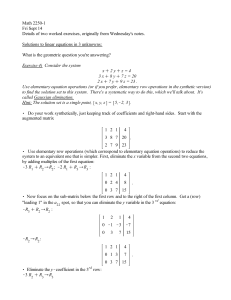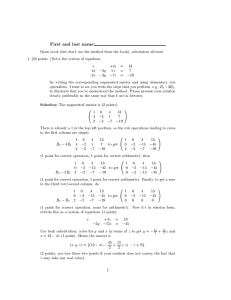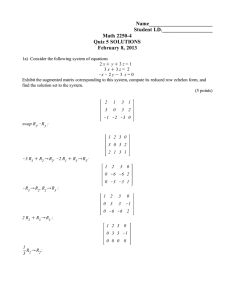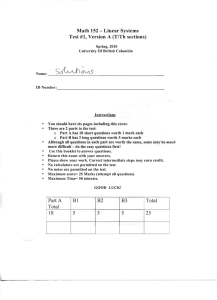Math 2250-4 Fri Feb 1 Solutions to linear equations in 3 unknowns:
advertisement
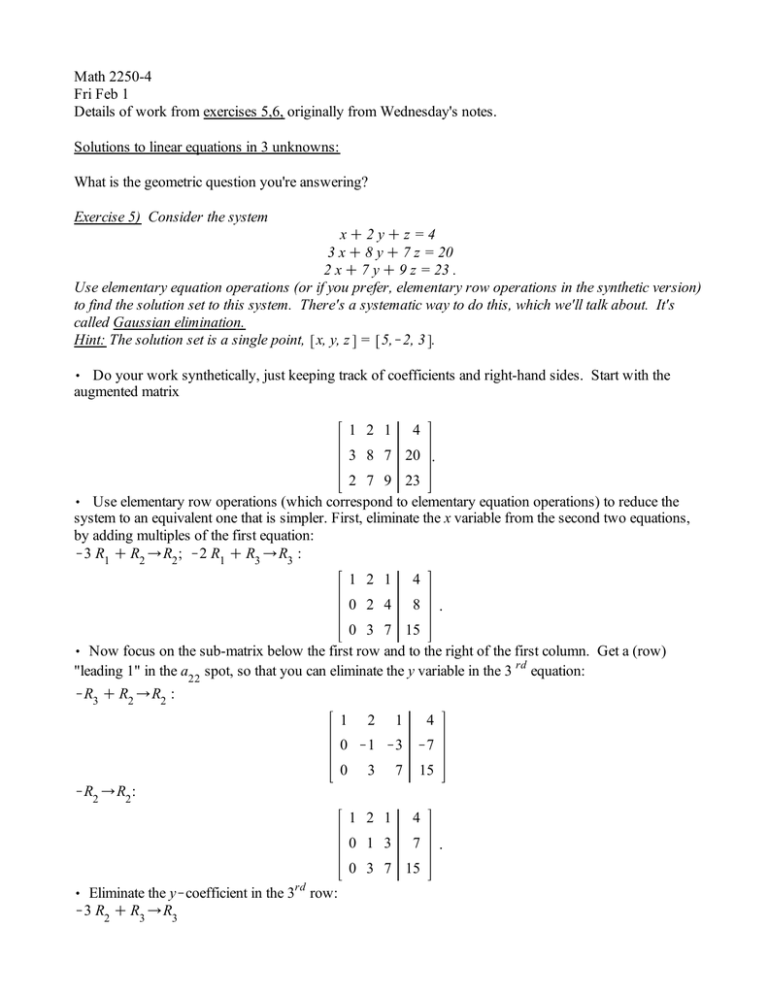
Math 2250-4 Fri Feb 1 Details of work from exercises 5,6, originally from Wednesday's notes. Solutions to linear equations in 3 unknowns: What is the geometric question you're answering? Exercise 5) Consider the system xC2 yCz = 4 3 x C 8 y C 7 z = 20 2 x C 7 y C 9 z = 23 . Use elementary equation operations (or if you prefer, elementary row operations in the synthetic version) to find the solution set to this system. There's a systematic way to do this, which we'll talk about. It's called Gaussian elimination. Hint: The solution set is a single point, x, y, z = 5,K2, 3 . , Do your work synthetically, just keeping track of coefficients and right-hand sides. Start with the augmented matrix 1 2 1 4 3 8 7 20 . 2 7 9 23 , Use elementary row operations (which correspond to elementary equation operations) to reduce the system to an equivalent one that is simpler. First, eliminate the x variable from the second two equations, by adding multiples of the first equation: K3 R1 C R2 /R2 ; K2 R1 C R3 /R3 : 1 2 1 4 0 2 4 8 . 0 3 7 15 , Now focus on the sub-matrix below the first row and to the right of the first column. Get a (row) "leading 1" in the a22 spot, so that you can eliminate the y variable in the 3 rd equation: KR3 C R2 /R2 : 1 2 1 4 0 K1 K3 K7 0 3 7 15 KR2 /R2 : 1 2 1 4 0 1 3 7 0 3 7 15 , Eliminate the yKcoefficient in the 3 K3 R2 C R3 /R3 rd row: . 1 2 1 4 0 1 3 7 . 0 0 K2 K6 rd , Get a leading 1 in the 3 R3 /R3 K2 row: 1 2 1 4 0 1 3 7 . 0 0 1 3 At this stage we could backsolve to find the solution: The third equation is z = 3 . Thus the second equation reads y C 3$3 = 7 so y =K2 . Thus the first equation reads x C 2 K2 C 1$3 = 4 so x = 5 . Thus the solution is x, y, z = 5,K2, 3 . However, it is usually easier to continue this process to get an even easier system. Except now we work from the bottom right back up to the top left. , Use the zKcoefficient in the 3rd equation to remove the zKvariable from the top 2 equations: K3 R3 C R2 /R2 ; KR3 C R1 /R1 : 1 2 0 1 0 1 0 K2 0 0 1 nd , Move left and up; use the y -coefficient in the 2 K2 R2 C R1 /R1 . 3 row to remove the yKvariable in the first row: 1 0 0 5 0 1 0 K2 0 0 1 . 3 Thus x, y, z = 5,K2, 3 . Exercise 6 There are other possibilities. In the two systems below we kept all of the coeffients the same as in Exercise 5, except for a33 , and we changed the right side in the third equation, for 6a. Work out what happens in each case. 6a) xC2 yCz = 4 3 x C 8 y C 7 z = 20 2 x C 7 y C 8 z = 20 . 6b) xC2 yCz = 4 3 x C 8 y C 7 z = 20 2 x C 7 y C 8 z = 23 . 6c) What are the possible solution sets (and geometric configurations) for 1, 2, 3, 4,... equations in 3 unknowns? Solution to 6a: As in the previous exercise we work from the top left to the lower right, and then reverse course: 1 2 1 4 3 8 7 20 2 7 8 20 K3 R1 C R2 /R2 ; K2 R1 C R3 /R3 : 1 2 1 4 0 2 4 8 . 0 3 6 12 R2 2 /R2 : 1 2 1 4 0 1 2 4 . 0 3 6 12 K3 R2 C R3 /R3 1 2 1 4 0 1 2 4 . 0 0 0 0 , Work with the "leading 1" in the second row, to eliminate the yKvariable in the first row. K2 R1 C R2 /R1 1 0 K3 K4 0 1 2 4 . 0 0 0 0 The two equations corresponding to this augmented matrix read x K 3 z =K4 yC2 z = 4 . Thus we may choose z arbitrarily, and solve for y, x. Let z = t 2 = . Then y = 4 K 2 t, x =K4 C 3 t . In vector form this reads x y = K4 C 3 t 4K2 t = z which is an entire line of solutions. Solution to 6b: t K4 4 C 0 3t K2 t = t K4 3 4 C t K2 0 1 1 2 1 4 3 8 7 20 2 7 8 23 K3 R1 C R2 /R2 ; K2 R1 C R3 /R3 : 1 2 1 4 0 2 4 8 . 0 3 6 15 R2 2 /R2 : 1 2 1 4 0 1 2 4 . 0 3 6 15 K3 R2 C R3 /R3 1 2 1 4 0 1 2 4 . 0 0 0 3 R3 3 / R3 1 2 1 4 0 1 2 4 . 0 0 0 1 , The last row of the augmented matrix stands for the equation 0 x C 0 y C 0 z = 1. Since there is no vector x, y, z that can make zero equal to 1, there are no solutions to this equation, and so there are no solutions to the final system of three equations, and so there is no solution either to the original system of equations. When a system of linear equations has empty solution set we call it an inconsistent system. Solution to 6c) Two planes in =3 can intersect in a line, the two planes themselves (if they're actually the same plane), or in the empty set (if they are parallel). In the first two cases the solution set of the corresponding linear system is infinite, in the third case it is empty. Three or more planse in =3 can intersect in a plane, a line, a point, or they may have no common intersection point.

